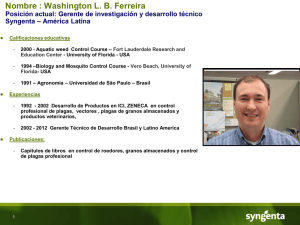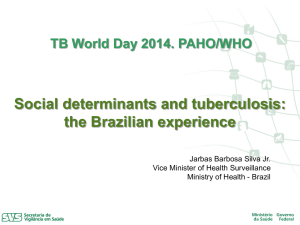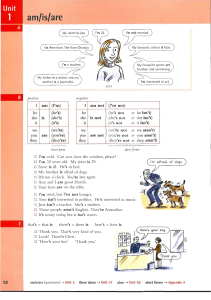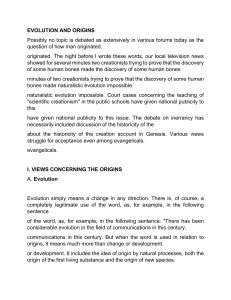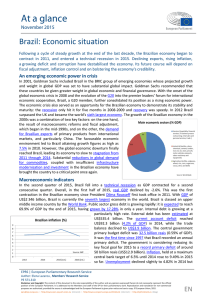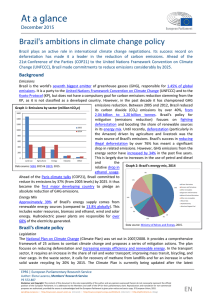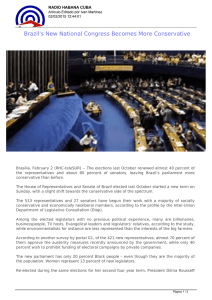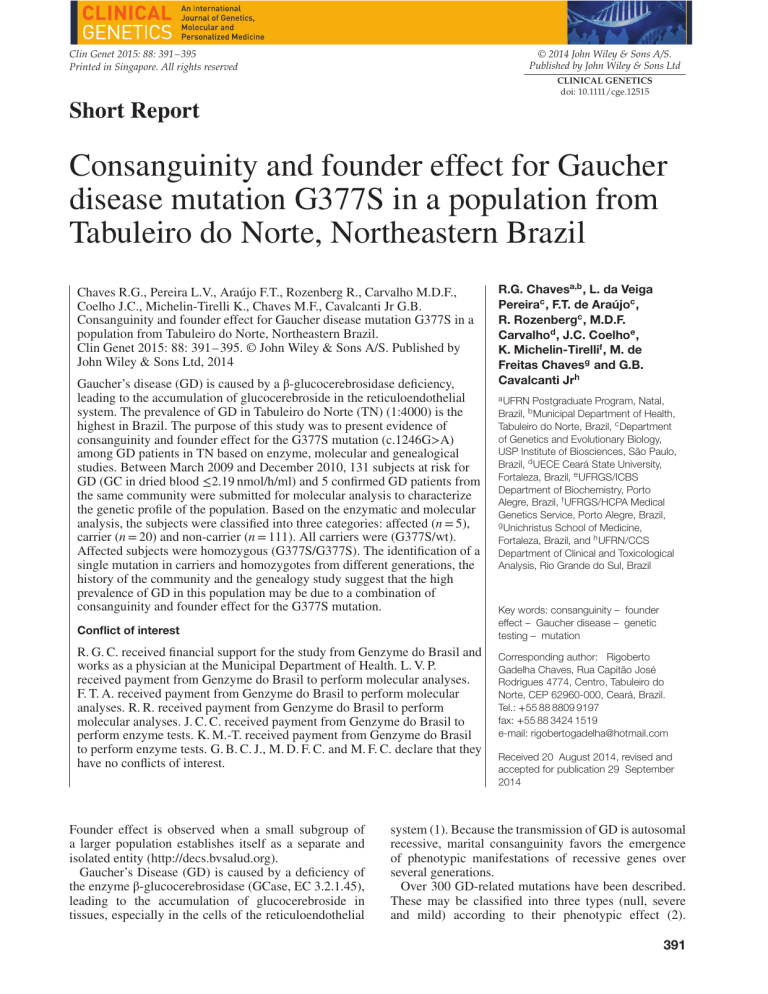
Clin Genet 2015: 88: 391–395 Printed in Singapore. All rights reserved © 2014 John Wiley & Sons A/S. Published by John Wiley & Sons Ltd CLINICAL GENETICS doi: 10.1111/cge.12515 Short Report Consanguinity and founder effect for Gaucher disease mutation G377S in a population from Tabuleiro do Norte, Northeastern Brazil Chaves R.G., Pereira L.V., Araújo F.T., Rozenberg R., Carvalho M.D.F., Coelho J.C., Michelin-Tirelli K., Chaves M.F., Cavalcanti Jr G.B. Consanguinity and founder effect for Gaucher disease mutation G377S in a population from Tabuleiro do Norte, Northeastern Brazil. Clin Genet 2015: 88: 391–395. © John Wiley & Sons A/S. Published by John Wiley & Sons Ltd, 2014 Gaucher’s disease (GD) is caused by a β-glucocerebrosidase deficiency, leading to the accumulation of glucocerebroside in the reticuloendothelial system. The prevalence of GD in Tabuleiro do Norte (TN) (1:4000) is the highest in Brazil. The purpose of this study was to present evidence of consanguinity and founder effect for the G377S mutation (c.1246G>A) among GD patients in TN based on enzyme, molecular and genealogical studies. Between March 2009 and December 2010, 131 subjects at risk for GD (GC in dried blood ≤2.19 nmol/h/ml) and 5 confirmed GD patients from the same community were submitted for molecular analysis to characterize the genetic profile of the population. Based on the enzymatic and molecular analysis, the subjects were classified into three categories: affected (n = 5), carrier (n = 20) and non-carrier (n = 111). All carriers were (G377S/wt). Affected subjects were homozygous (G377S/G377S). The identification of a single mutation in carriers and homozygotes from different generations, the history of the community and the genealogy study suggest that the high prevalence of GD in this population may be due to a combination of consanguinity and founder effect for the G377S mutation. Conflict of interest R. G. C. received financial support for the study from Genzyme do Brasil and works as a physician at the Municipal Department of Health. L. V. P. received payment from Genzyme do Brasil to perform molecular analyses. F. T. A. received payment from Genzyme do Brasil to perform molecular analyses. R. R. received payment from Genzyme do Brasil to perform molecular analyses. J. C. C. received payment from Genzyme do Brasil to perform enzyme tests. K. M.-T. received payment from Genzyme do Brasil to perform enzyme tests. G. B. C. J., M. D. F. C. and M. F. C. declare that they have no conflicts of interest. Founder effect is observed when a small subgroup of a larger population establishes itself as a separate and isolated entity (http://decs.bvsalud.org). Gaucher’s Disease (GD) is caused by a deficiency of the enzyme β-glucocerebrosidase (GCase, EC 3.2.1.45), leading to the accumulation of glucocerebroside in tissues, especially in the cells of the reticuloendothelial R.G. Chavesa,b , L. da Veiga Pereirac , F.T. de Araújoc , R. Rozenbergc , M.D.F. Carvalhod , J.C. Coelhoe , K. Michelin-Tirellif , M. de Freitas Chavesg and G.B. Cavalcanti Jrh a UFRN Postgraduate Program, Natal, Brazil, b Municipal Department of Health, Tabuleiro do Norte, Brazil, c Department of Genetics and Evolutionary Biology, USP Institute of Biosciences, São Paulo, Brazil, d UECE Ceará State University, Fortaleza, Brazil, e UFRGS/ICBS Department of Biochemistry, Porto Alegre, Brazil, f UFRGS/HCPA Medical Genetics Service, Porto Alegre, Brazil, g Unichristus School of Medicine, Fortaleza, Brazil, and h UFRN/CCS Department of Clinical and Toxicological Analysis, Rio Grande do Sul, Brazil Key words: consanguinity – founder effect – Gaucher disease – genetic testing – mutation Corresponding author: Rigoberto Gadelha Chaves, Rua Capitão José Rodrigues 4774, Centro, Tabuleiro do Norte, CEP 62960-000, Ceará, Brazil. Tel.: +55 88 8809 9197 fax: +55 88 3424 1519 e-mail: rigobertogadelha@hotmail.com Received 20 August 2014, revised and accepted for publication 29 September 2014 system (1). Because the transmission of GD is autosomal recessive, marital consanguinity favors the emergence of phenotypic manifestations of recessive genes over several generations. Over 300 GD-related mutations have been described. These may be classified into three types (null, severe and mild) according to their phenotypic effect (2). 391 Chaves et al. The presence of mutations in both alleles may lead to one of three phenotypical manifestations: type 1 nonneuropathic (MIM 230800), type 2 neuropathic (MIM 230900) and type 3 subacute neuropathic (MIM 231000). The genotype/phenotype correlation is limited owing to many variations in the clinical manifestations of patients with the same genotype (3), although some genotypes are associated with milder symptomatology. The diagnosis may be established by the detection of Gaucher cells in tissues, by GCase activity in leukocytes or cultured skin fibroblasts, or by molecular analysis (1, 4, 5). Populations at risk may be screened for GCase and chitotriosidase activity using dried blood spots on filter paper (DBS-FP) (6, 7). GD is panethnic but is particularly prevalent among Ashkenazi Jews. In the United States, the estimated incidence is 1:40,000 (8). In Brazil, 566 GD patients had been diagnosed by March 2014 (9). In Tabuleiro do Norte (TN), a town in Northeastern Brazil with approximately 28,500 inhabitants, the prevalence of GD is 1:4000 (10). The town was founded in the second half of the 17th century by Portuguese settlers of Sephardic Jewish extraction (11). A combination of inbreeding, a common local practice until a few decades ago, and founder effect for the G377S mutation, may explain the high prevalence of GD in this population. The objective of the study was to present evidence of founder effect for the G377S mutation in a population of GD patients and carriers from TN. Methods The molecular study protocol was approved by the National Research Ethics Commission (CONEP) in February 2009. The sampling was done in TN between 1 March 2009 and 31 December 2010. The population study was based on three strategic pillars: health education, screening for GD and genealogy study of the families involved. Screening was done in three steps (Fig. 1). • Step 1: Evaluation of GCase and chitotriosidase activity in DBS-FP collected from residents of TN volunteering for the study (10). • Step 2: Evaluation of GCase activity in leukocytes and of chitotriosidase in plasma collected from participants selected in Step 1 (10). • Step 3: Molecular analysis of participants selected in Step 2 and of five residents with confirmed GD. The study started with population screening for GCase activity for three reasons: (i) the genetic profile of the population was unknown prior to the study, (ii) the cost of large-scale DNA analysis was prohibitive and (iii) genetic research facilities were unavailable in the region. The participants were volunteers residing in TN descended from local traditional families. All participants were required to attend at least one GD-related health education session and to sign an informed consent form. No financial or material compensation was 392 provided. Having been evaluated previously, relatives in the first degree of patients with confirmed diagnosis of GD were not invited to participate in the screening. The evaluation of enzyme activity in DBS-FP was performed with the technique developed by Civallero (7). The cutoff values were ≤2.19 nmol/h/ml for GCase activity in leukocytes and ≥44.00 nmol/h/ml for chitotriosidase activity in plasma. Participants below the GCase cutoff value or above the chitotriosidase cutoff value in the first step of the screening process were referred for evaluation of GCase activity in leukocytes and chitotriosidase activity in plasma according to standard methods described in the literature (12, 13) and to DNA screening for four common Brazilian mutations. Screening for G377S, N370S, L444P and 55-del, the most relevant mutations in Brazil (14), was performed on exfoliated buccal mucosa cell DNA, as described in the literature (15). Patients found to be homozygous for G377S were referred for screening for 55-del in the pseudogene contiguous to the GBA gene (psGBA). When present, this deletion occurs at the annealing sites of the primers used for detecting N370S, L444P and G377S. If the presence of 55-del is due to a recombination event, a false positive result of homozygosis may occur. To rule out the presence of mutations other than the four mutations screened for, blood samples of participants with GCase activity in leukocytes ≤4.0 nmol/h/mg protein were submitted for DNA sequencing of the gene region encoding for GCase. The statistical analysis was performed with the software IBM SPSS version 20 (2011). The results were expressed as distribution of frequencies, central tendency, dispersion, minimum values and maximum values. Categories were compared pairwise with the Steel–Dwass–Critchlow–Fligner test for nonparametric data. The Kruskal–Wallis test was used to compare three categories simultaneously. The level of statistical significance was set at 5% (p < 0.05). The reconstruction of the genealogy of the involved families was based on interviews with the participants, their relatives and information provided by Prof Marcondes Andrade, a local historian. Using the software GenoPro® 2011 version 2.5.4.1, genograms were built from the collected data. Results During Step 1 of the population screening, 740 DBS-FP samples were evaluated for GCase and chitotriosidase activity. The participants were aged 31.4 ± 19.2 years (range: 2–81) and most were women (n = 496; 67%). As participation in this study was voluntary, we found that women were more prone to collaborate. Nearly one fifth (n = 135; 18.2%) were found to be at risk for GD (GCase in DBS-FP ≤2.19 nmol/h/ml) (10). In Step 2, four of the 135 participants at risk declined participation. Thus, 131 participants (86 women) aged 34.17 ± 19.62 years (range: 2–77) were submitted for Consanguinity and founder effect Step1 Evaluation of glucocerebrosidase and chitotriosidase activity in dried blood on filter paper Normal GCase > 2.19 nmol/h/mL Chito < 44.00 nmol/h/mL Step 2 At risk GCase ≤ 2.19 nmol/h/mL Chito ≥ 44.00 nmol/h/mL Evaluation of glucocerebrosidase activity in leukocytes and chitotriosidase activity in plasma Normal At risk At high risk GCase >16.4 nmol/h/mg protein GCase 5.6 -16.4 nmol/h/mg protein GCase ≤ 5.5 nmol/h/mg protein Step 3 Non-carrier Molecular analysis of mutations N370S, G377S, L444P and 55-del Carrier Affected DNA sequencing Clinical evaluation Lab tests Ultrasonography Bone densitometry Genetic counseling Radiology Magnetic resonance Fig. 1. Design of population screening for Gaucher’s disease in Tabuleiro do Norte, Ceará, Brazil, 2009–2010. Source: the authors. evaluation of GCase activity in leukocytes, chitotriosidase activity in plasma and screening for the mutations N370S, L444P, G377S and 55-del (10). A group of five patients with confirmed diagnosis of GD and both parents descended from early settlers of TN was added to the group of 131 participants selected for screening for the mutations N370S, L444P, G377S and 55-del in order to compare their genotypes to the mutations identified in the 131 selected participants in Step 1. The five patients were diagnosed between 1977 and 2007 based on GCase levels in leukocytes and clinical symptoms only. Screening for the four most common mutations in Brazil resulted in the identification of G377S only, making it possible to classify the participants in three categories according to genotype: non-carriers (n = 111; 81.6%), carriers (n = 20; 14.7%) and affected (n = 5; 3.7%) (Table 1). The DNA sequencing based on DBS-FP of the four participants with GCase in leukocytes ≤4.0 nmol/h/mg protein confirmed the diagnosis of two carrier subjects (G377S/wt) and two non-carriers (wt/wt) (10). Our genealogy study included 12 family generations and 583 subjects (52.6% women) from 181 nuclear families in TN who established 778 pedigree links during a period of over 300 years. The earliest ancestor identified by name was born in Cartaxo, Portugal, in 1646 (Family 1) and migrated to Brazil in 1690 along with four children. Two of these settled in what was to become TN and married the two daughters of a couple of Portuguese descendants (Family 2). Inbreeding became commonplace over time in the isolated rural community of TN, favoring the emergence of homozygotes and carriers of the mutation G377S (Fig. 2). Our data provide evidence of significant levels of inbreeding. Thus, although 66 different surnames were registered among the 136 individuals in the final sample, 50% belong to only 8 families. The 20 carriers have 21 different surnames, but 47% have at least one surname in common. Forty percent of the carriers reported that their parents were cousins in the first degree. The five affected subjects belong to four families descended from common ancestors. Two are sisters, and all are cousins of the second or third degree, suggesting a strong pattern of consanguinity. Discussion The G377S mutation is the fourth most prevalent GD-related mutation in Spain (n = 25; 3.0%) (2) and 393 Chaves et al. Table 1. Affected subjects, carriers and non-carriers of mutations for Gaucher’s disease according to gender, age and enzyme activity (GCase activity in leukocytes and chitotriosidase activity in plasma)a Subjects according to genetic status Variables Non-carrier Carrier G377S/wt Affected G377S/G377S Total p-value n (%) Gender Female n (%) Male n (%) Age (years) Average Standard deviation Minimum–maximum Confidence interval (95%) GCase (nmol/h/mg protein) Average Standard deviation Minimum–maximum Confidence interval (95%) Chitotriosidase (nmol/h/ml) Average Standard deviation Minimum–maximum Confidence interval (95%) Type of mutation 111 (81.6) 20 (14.7) 5 (3.7) 136 (100) 69 (62.2) 42 (37.8) 14 (70.0) 6 (30.0) 3 (60.0) 2 (40.0) 86 (63) 50 (37) 0.791 35.51 20.20 2–76 31.71–39.31 26.70 14.25 6–48 20.03–33.37 33.40 10.35 22–45 20.54–46.26 34.14 19.34 2–76 30.86–37.42 0.242 10.47 3.01 4.00–20.00 9.90–11.40 6.70 2.03 2.60–10.00 5.74–7.65 1.92 1.78 0.13–4.80 0.00–4.14 9.48 3.48 0.13–20.00 9.01–10.20 <0.001 51.46 57.42 0.80–381.00 40.66–62.26 wt/wt 51.54 32.64 0.80–144.00 36.26–66.81 G377S/wt 18,129.40 8714.61 9110–31,543 7308–28,950 G377S/ G377S 716.10 3729.00 0.8–31,543 83.56–1349 - <0.001 - GCase, β-glucocerebrosidase. a Comparisons involving three categories simultaneously were done with the Kruskal–Wallis test. Pairwise comparisons of categories were done with the Dwass–Steel–Critchlow–Fligner test for non-parametric data. Source: The authors, 2010. the third most prevalent in both Portugal (n = 4; 7.4%) (16) and Brazil (n = 11; 2.2%) (14). Initially, it was believed to be neuroprotective owing to its mild effect, high residual enzyme activity and the fact that all known Portuguese homozygotes for G377S have type 1 GD (17). However, the G377S mutation has been observed in patients with type 3 GD in both Brazil and the Iberian Peninsula (2, 14). Although cardiac valvulopathies have been observed in a homozygous patient from Croatia, all our subjects had type 1 GD and no cardiovascular symptoms. This suggests that individuals with the same genotype may have different phenotypes and highlights the influence of other genetic and/or environmental factors on the clinical manifestations of GD (2, 18). The fact that the carriers and affected subjects identified in this study are descendents of Jewish immigrants from Cartaxo, Portugal (11), and that the mutation G377S has been observed in homozygosis in one Portuguese Sephardic Jewish patient suggests that the G377S mutation may be Sephardic in origin (16), although the gene frequency of this mutation is not significant among Jewish subjects (3, 19). Genotype/biochemical phenotype correlations The participants were classified into three genotype categories: affected, carriers and non-carriers. The 394 categories did not differ significantly with regard to average age (p = 0.242) or gender (p = 0.791) (Table 1). In our sample, carriers and affected subjects displayed 56.72% (p < 0.001) and 18.3%, respectively, of the average GCase activity in leukocytes of non-carriers. However, despite the significant differences in average GCase activity in leukocytes between the three categories (p < 0.001), the enzyme tests were unable to distinguish carriers reliably from non-carriers. Chitotriosidase activity in plasma is usually above normal in GD. This makes the chitotriosidase test a useful tool in the diagnosis and follow-up of GD patients (12). In this study, average chitotriosidase activity levels were significantly higher in affected subjects than in carriers (p = 0.002) and approximately 350 times higher in affected subjects than in non-carriers (p < 0.001). However, carriers and non-carriers did not differ significantly (p = 0.34). We believe that the observed founder effect for the G377S mutation may be attributed to the Portuguese ancestors of the early settlers of TN. However, it remains to be determined whether the presence of G377S in this population is related to the Sephardic Jewish origin of these ancestors. In conclusion, the identification of a single mutation (G377S) in 20 carriers and five affected subjects, belonging to different generations but descending from common ancestors, suggests that the high prevalence of GD Consanguinity and founder effect Fig. 2. Genogram of homozygotes and carriers of the mutation G377S in Tabuleiro do Norte. Source: the authors. in TN is due to a combination of founder effect for the G377S mutation and consanguinity. Acknowledgements The authors would like to thank Genzyme do Brasil for financial support. Also thanks to Dr Elisa Sobreira for academic support and to Mr João Márcio da Silva (head of the Municipal Health Department) and the health care workers of the local facility for their valuable cooperation. We are grateful to Dr Rômulo Maurício for preparing blood samples for enzyme analyses and to Tibelle Freitas Maurício (nurse) for her contribution to the health education sessions. Finally, our thanks to Edineide Chaves (social worker) and to Prof Marcondes Andrade for helping draw the family trees of the involved families. References 1. Beutler E, Grabowski GA. Gaucher disease. In: Scriver CR, Beaudet AL, Sly WS, Valle D, eds. The metabolic and molecular bases of inherited diseases, 8th edn. New York, NY: McGraw-Hill, 2001: 3635–3668. 2. Giraldo P, Alfonso P, Irun P et al. Mapping the genetic and clinical characteristics of Gaucher disease in the Iberian Peninsula. Orphanet J Rare Dis 2012: 7: 17. 3. Hruska KS, LaMarca ME, Scott CR, Sidransky E. Gaucher disease: mutation and polymorphism spectrum in the glucocerebrosidase gene (GBA). Hum Mutat 2008: 29 (5): 567–583. 4. Beutler E, Saven A. Misuse of marrow examination in the diagnosis of Gaucher disease. Blood 1990: 76 (3): 646–648. 5. Charrow J, Esplin JA, Gribble TJ et al. Gaucher disease: recommendations on diagnosis, evaluation, and monitoring. Arch Intern Med 1998: 158 (16): 1754–1760. 6. Chamoles NA, Blanco M, Gaggioli D, Casentini C. Gaucher and Niemann-Pick diseases–enzymatic diagnosis in dried blood spots on filter paper: retrospective diagnoses in newborn-screening cards. Clin Chim Acta 2002: 317 (1-2): 191–197. 7. Civallero G, Michelin-Tirelli K, de Mari J et al. Twelve different enzyme assays on dried-blood filter paper samples for detection of patients with 8. 9. 10. 11. 12. 13. 14. 15. 16. 17. 18. 19. selected inherited lysosomal storage diseases. Clin Chim Acta 2006: 372 (1-2): 98–102. Grabowski GA. Gaucher disease: lessons from a decade of therapy. J Pediatr 2004: 144 (Suppl. 5): S15–S19. International Collaborative Gaucher Group Gaucher Registry (2014). Population Report: Latin America compared to Rest of World, International Collaborative Gaucher Group: 35. Chaves RG, Coelho JC, Michelin-Tirelli K et al. Successful screening for Gaucher disease in a high-prevalence population in Tabuleiro do Norte (Northeastern Brazil): a cross-sectional study. JIMD Rep 2011: 1: 73–78. DOI: 10.1007/8904_2011_19. Vieira VMG (2000). Os Gadelhas no Mundo. Retrieved July13, 2009, from http://www.gentree.org.br/artigos/gadelha.htm Hollak CE, van Weely S, van Oers MH, Aerts JM. Marked elevation of plasma chitotriosidase activity. A novel hallmark of Gaucher disease. J Clin Invest 1994: 93 (3): 1288–1292. Peters SP, Coyle P, Glew RH. Differentiation of beta-glucocerebrosidase from beta-glucosidase in human tissues using sodium taurocholate. Arch Biochem Biophys 1976: 175 (2): 569–582. Rozenberg R, Araujo FT, Fox DC et al. High frequency of mutation G377S in Brazilian type 3 Gaucher disease patients. Braz J Med Biol Res 2006: 39 (9): 1171–1179. Richards B, Skoletsky J, Shuber AP et al. Multiplex PCR amplification from the CFTR gene using DNA prepared from buccal brushes/swabs. Hum Mol Genet 1993: 2 (2): 159–163. Amaral O, Marcao A, Sa Miranda M, Desnick RJ, Grace ME. Gaucher disease: expression and characterization of mild and severe acid beta-glucosidase mutations in Portuguese type 1 patients. Eur J Hum Genet 2000: 8 (2): 95–102. Amaral O, Lacerda L, Marcao A, Pinto E, Tamagnini G, Sa Miranda MC. Homozygosity for two mild glucocerebrosidase mutations of probable Iberian origin. Clin Genet 1999: 56 (1): 100–102. Peric Z, Kardum-Skelin I, Puskaric BJ, Letilovic T, Vrhovac R, Jaksic B. An unusual presentation of Gaucher’s disease: aortic valve fibrosis in a patient homozygous for a rare G377S mutation. Coll Antropol 2010: 34 (1): 275–278. Koprivica V, Stone DL, Park JK et al. Analysis and classification of 304 mutant alleles in patients with type 1 and type 3 Gaucher disease. Am J Hum Genet 2000: 66 (6): 1777–1786. 395

